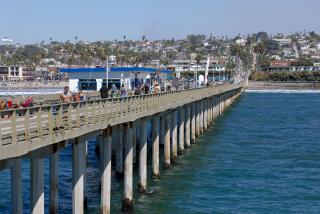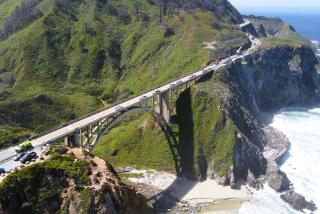Ready to stick a fork in Hatteras Island road
Six weeks after Hurricane Irene severed the only road to Hatteras Island, North Carolina’s long struggle to reconnect the barrier island’s 3,300 stranded residents to the mainland is almost over. The badly battered Highway 12 is finally due to reopen early this week.
The reopening has required much more than just fixing a road. Highway 12, a slender ribbon of asphalt, is built on shifting sand. The island it serves refuses to stay in one place, buffeted by powerful tides and punishing storms.
And Hatteras Island is no longer even an intact island. Irene severed it in two places, and waters from the Pamlico Sound now flow unimpeded into the Atlantic Ocean.
But even as crews wrap up road repairs and erect a temporary 662-foot bridge over the worst-hit section, some environmentalists and geologists are calling the effort a colossal waste of time and money. It’s pure folly, they say, to keep repairing a vulnerable, exposed highway on the shifting sands of a rapidly eroding barrier island.
Some suggest building a 17-mile alternative, dubbed the “long bridge,” over the sound to bypass Highway 12’s most vulnerable sections; they also propose expanding the state’s ferry system. Such measures would let nature take its course as the islands form and reform.
“The state is just filling those holes in the road with money,” says Dorothea V. Ames, a geologist at East Carolina University, who favors ferries over bridges.
**
Spending huge sums to ensure automobile access to unstable barrier islands has long been a contentious issue along the East Coast. But the fight is especially intense on North Carolina’s Outer Banks, which jut into the Atlantic like an elbow, narrower and more exposed than most other East Coast barrier islands. With its tourism and sport and commercial fishing, the area is crucial to North Carolina’s economy.
The state has poured millions into holding back the seas. Officials say road repairs — along with dredging and man-made groins and berms — preserve property and livelihoods, and ensure public access to beaches and the Cape Hatteras National Seashore.
The state is pushing ahead with pre-Irene plans to build a 2.8-mile, $216-million bridge that ties into the most badly damaged sections of Highway 12. It would replace the 2.7-mile Herbert C. Bonner Bridge, built in 1962, which lost its crucial link to Highway 12 when Irene severed the highway five miles south.
Yet the bridge is rendered useless whenever storms rupture Highway 12, which has happened many times since it was built in 1954. Irene has forced most road repair crews and vehicles to take a two-hour ride on the state’s lumbering emergency ferry to Hatteras from Stumpy Point.
The state Department of Transportation says it is proceeding with road repairs and bridge work while experts come up with long-term recommendations for Gov. Bev Perdue.
The Southern Environmental Law Center sued the state in July, saying its plans for the bridge did not comply with federal environmental laws. Derb S. Carter Jr., a director at the center, said the state’s own hired consultants had warned that constantly re-repairing Highway 12 is an expensive and never-ending battle.
The state said the allegations were not substantiated and asked a judge to dismiss the suit.
Warren Judge, chairman of the Board of Commissioners in Dare County, which includes almost all of the Outer Banks, accuses environmentalists of “obstructing the progress” of a badly needed bridge and crucial road work. Several hundred island homes were flooded by Irene.
“It’s easy for naysayers to say there will always be problems with that highway, but you have to take care of your assets,” Judge said.
Judge said the “long bridge” would cost far too much, and cause environmental damage to Pamlico Sound and its fisheries and migratory birds. Some cost estimates for the long bridge have exceeded $1 billion.
A new scientific paper by geologist Ames and research partner Stanley R. Riggs says the state has spent at least $100 million since 1983 to repair Highway 12 and its Bonner Bridge links. The cost for the temporary bridge and current Highway 12 repairs has been estimated at $13 million.
The state will have to spend at least $930 million to keep the road open for the next century, the geologists estimated.
“The state is just kicking the can down the road,” Ames said.
The geologists say the island is inexorably drifting west toward the sound at 13 feet per year at the 12-mile-long Pea Island National Wildlife Refuge, fatally undermining Highway 12. The state’s efforts to stabilize Hatteras actually make the island more unstable by interfering with its natural migration westward, they said.
“It is virtually impossible to maintain a fixed road on a constantly shifting pile of sand,” they wrote.
Disagreement over access to Hatteras Island extends even to terminology.
Local officials call the severed road sections “breaches,” which implies temporary damage. Geologists say the two biggest ruptures are new inlets, nature’s way of replenishing the islands as they shift.
“They call it a breach because it doesn’t sound so bad,” Ames said. If water runs freely between the sound and the ocean, she said, it’s an inlet.
“It’s a breach,” said Judge, the commissioner. “If you want drama, call it an inlet.”
**
Whatever they’re called, the ruptures continue to cut off Hatteras Island’s seven villages. Many residents are trying to repair damaged homes and businesses when the only access is via ferries.
Martha Weigel and William T. Draper waited in punishing midday sun at Stumpy Point recently to board the ferry for Hatteras. Weigel was on her first post-Irene visit to the house her father built in 1932, which was flooded by the storm.
Most islanders favor the “long bridge” solution, she said: If the bridge had been built when first proposed years ago, when costs were lower, it would have paid for itself over time.
Draper, a longtime coastal resident, said Hatteras natives had adapted to storms and road closures. Most are self-sufficient and can survive for a while if cut off from the mainland, he said.
“People would love that long bridge and have guaranteed access, if there was just a way to pay for it,” Draper said.
In the meantime, he said, the winds will blow and the sands will shift as the island creeps inexorably toward the sound.
“It’s an unstable place,” he said. “That’s the nature of the beast.”
More to Read
Sign up for Essential California
The most important California stories and recommendations in your inbox every morning.
You may occasionally receive promotional content from the Los Angeles Times.











